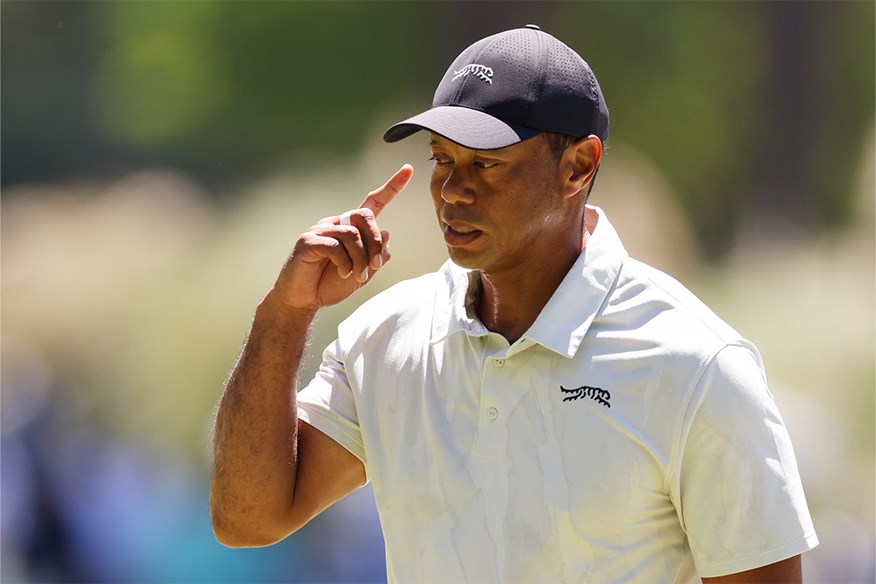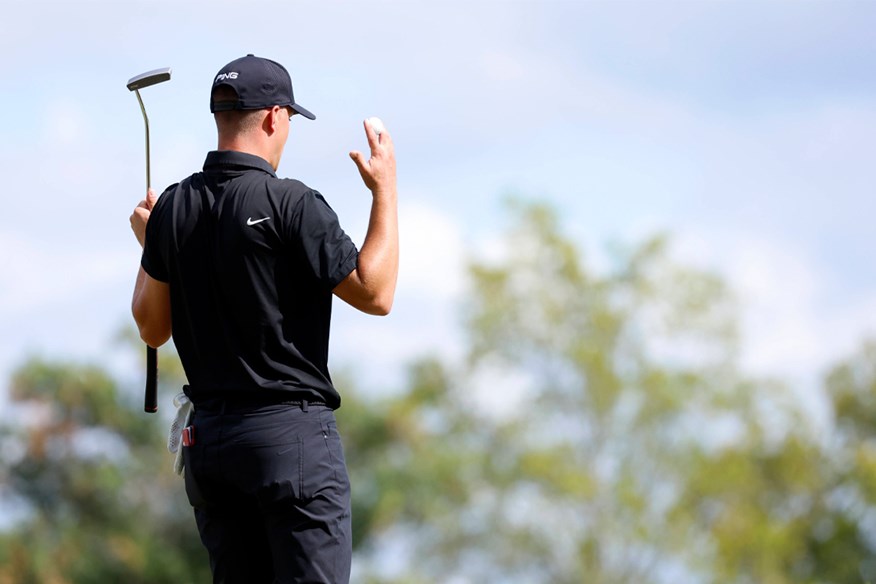Watching this PGA Tour player score a 13 on one hole will make you a better golfer
Last updated:
William Mouw’s misfortunate makes for riveting watching – but can also be a fantastic golf lesson for all of us.
I’ve always thought that being a PGA Tour rookie must be a bit like when you make the step up to big school as a kid. You go from a level where you’re feeling comfortable and excelling to suddenly finding yourself among the bigger kids (established tour pros and major winners) and needing to prove yourself all over again.
If that analogy works – and let’s just pretend that it does – then making an octuple-bogey 13 on a par-5 must be the equivalent of wetting yourself during assembly or accidentally calling the teacher “mum” in front of the whole class.
It’s what happened to PGA Tour rookie William Mouw during the second round of The American Express (the 13 on a par-5, not the other mishaps), leading to his second missed cut in two starts since making the step up from the Korn Ferry Tour.

How William Mouw made a 13 on the PGA Tour
The 24-year-old was ticking along nicely as he reached the par-5 16th hole at the PGA West Stadium Course. He’d carded an opening-round 68 on the Thursday and was 2-under-par thru 15 holes of his second round, sitting at 6-under for the tournament.
He found the fairway with his tee shot and went for the green from 275 yards. And then things got messy.
Mouw’s approach shot found an 18’-deep bunker that guards the lefthand side of the 16th green.
He escaped at the first attempt but hit the shot too clean, airmailing the green and ending up in a sandy wasteland.
His fourth shot was also a bit on the thin side, skipping across the green straight back into the original bunker.
It then took him three attempts to get out.
When he did, he ended up over the green again.
If you’re struggling to keep up, we’re now on shot 8, coming from the sandy wasteland. Again.
A delicate chip looked to have finally found the green and garnered applause from the crowd, but the ball picked up speed down the slope and – you guessed it – rolled back into that cavernous sand trap. As it did, hilariously, the bunker was still being raked after his previous three-shot visit.
For his 9th, Mouw sensibly decided to aim away from the green and just find the safety of green grass.
Sadly, he then thinned a chip shot into what I was starting to think was his favorite holiday destination, the sandy wasteland behind the green.
He managed to knock his 11th (eleventh) shot onto the green and, impressively, two-putted from 65’5” to score an octuple-bogey 13 and put an end to the misery.
At least, put an end to the misery until the following hole… where he found the water on the par-3 17th en route to a triple bogey.
Mouw went from 6-under to 2-over in one hole, and 6-under to 5-over in the space of two holes. Ouch.
How Mouw’s 13 can make you a better golfer
Mouw wears a bracelet on his right wrist that says ‘NEVER EVER GIVE UP’.
His attitude during that greenside disaster and in the 24 hours after showed that he lives by that mantra.
We’ve all had nightmare holes. Getting stuck in a bunker. Having to reload multiple times on the same tee. Blading chips back and forth across a green like something from a Carry On film. And we’ve all witnessed others going through the same thing.
But how many of us can say we’ve maintained our composure as well as Mouw?
One fan on Instagram summed it up perfectly:
“No club throws, body language remained the same on every shot, didn’t give up, and stayed focused to 2 putt from 60+ feet. Shoutout @williamouw for setting a positive example for the kids – this kid is going to be a total STUD on Tour.“
As Walt Disney once said: “All the adversity I’ve had in my life, all my troubles and obstacles, have strengthened me. You may not realize it when it happens, but a kick in the teeth may be the best thing in the world for you.”
Every golf instruction book I’ve ever read has talked about taking one shot at a time. But it can be so hard to do that following a series of duffed chips or when you’re hitting shot number nine off the tee having sliced four in a row straight out of bounds.
If you watched Mouw hit any of his numerous shots in isolation, you wouldn’t know what had come before it. Before each shot, he reset himself, refocused, and stuck to the same process he would go through at any other time. That takes huge mental strength and will set him up well for the future when he, like all of us, faces more adversity on the course.
The following day, he made nine birdies on his way to a 67.
“It’s something that when it’s happening you just have to laugh at it and accept it and move on and laugh at it,” reflected Mouw. “Stuff happens, man. Golf’s a crazy game. And looking at the big picture and seeing things and moving on and having nine birdies today and bouncing back in a positive way is meaningful to me. And that’s how I took it. And yeah, I’m proud of myself.
“Golf is a lot like life, man. There’s adversity and as a player and as a student of the game and as a person of life, it’s not about dwelling on adversity. [It’s about] how can you turn adversity into positivity and use that to fuel you to get better and look at the bigger picture? And it’s something I did and I’m happy to set an example.”

Mouw’s behavior and reflections reminded me of the greatest golfer of my generation, if not all-time, Tiger Woods.
Tiger famously has a 10-step rule. After a bad shot, you can be as angry as you like, but you have to forget about it and move on by the time you’ve taken your next 10 steps up the hole.
It’s how you stop one bad shot ruining a whole round and, perhaps more importantly, from ruining your whole day.
How Mouw’s 13 compares to the worst-ever scores for a single hole on the PGA Tour
Mouw’s 13 certainly wasn’t the worst single-hole score ever recorded on the PGA Tour.
In fact, that number looks positively tidy compared to the worst single-hole scores ever recorded on the PGA Tour…
18
Remember a few years ago when Bryson DeChambeau cut the corner of the famous par-5 6th at Bay Hill and got within a flick of the green?
Well, he wasn’t the first to attempt it. John Daly started that trend (can two people in the space 25 years be a trend?) back in 1998. Sadly for Big John, he was less successful than DeChambeau, finding the water six times before eventually managing to find dry land.
19
Three players in PGA Tour history have just missed out on getting into the 20s on a single hole.
We’ll start with Ray Ainsley – not only because he was the first to scribble a 19 on his scorecard, but because it is also the highest single-hole score ever recorded in a major championship. Ainsley’s horror show came on the 16th at Cherry Hills during the 1938 US Open, where the history books say he refused to take a penalty drop after his ball landed in a creek and he spent half an hour thrashing away in the water, as well as a moment of madness where he threw his club in a fit of rage that cost him four more shots. Surprisingly, he missed the cut.
Hans Merrell also clocked up a two, this time at the 1959 Bing Crosby National Pro-Am. He got into trouble with sand and ice plants on the 16th at Cypress Point before eventually declaring his ball unplayable and then missing a 20-footer for an 18.
Dale Douglass‘ 20 minutes of pain came at the same tournament but this time at Pebble Beach in 1963. The American, who would later go on to win the U.S. Senior Open, hit it off the course towards the adjacent beach, where his ball initially lodged at the base of a cliff. He tried several times to hit it out of that spot, and the ball finally rolled out onto the sand, but into an unplayable lie. He took 14 strokes (including penalty strokes) to eventually get the ball back onto the fairway, three more to reach the green, and then two-putted for a 19.
“I was trying my best on all the shots, but you just couldn’t get any footing,” he explained.
23
Tommy Armour is generally considered one of the finest golfers to have ever played the game. The Edinburgh-born American won 25 times as a professional, including three majors, and was a Masters victory away from completing the modern Grand Slam.
But it wasn’t all plain sailing. In the 1927 Shawnee Open, Armour took a record 23 shots to complete the 17th hole, having gone out of bounds no fewer than ten times.
Somewhat bizarrely, this happened just days after his major breakthrough at the US Open, so perhaps he was still celebrating.
Want to avoid making a 13 next time you play? Here’s how to stay out of big trouble off the tee


